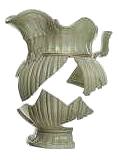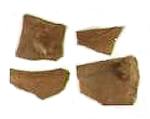Collections for Research

Monterey SHP, Cooper Molera
Many artifacts have been discovered in the refuge deposits of the homes of Captain John Rogers Cooper and Mexican merchant, Manuel Diaz. These artifacts provide a remarkable look at the impressive array of material culture available in this mid to late 19th century seaport town, the Mexican capital of Alta California.

Fort Ross SHP
Numerous archaeological excavations at this coastal location, which was at one time occupied by the Kashaya Indians, the Russian America Company, and families of ranchers and loggers right up to the mid-20th century, have produced artifacts reflecting the many cultures that inhabited this part of the rugged upper Sonoma Coast.

Old Sacramento SHP
This collection includes artifacts from the early waterfront town of Sacramento, ranging from the Gold Rush period to the beginning of the 20th Century. Four major phases of archaeological excavation are represented: the 1960s Freeway (I-5) project; the excavation of the area where Macy’s Department store was later built; excavations for the California State Railroad Museum; and the 1849er Scene, the heart of Old Sacramento. Many ethnic groups and cultures are represented in this collection.

Santa Cruz Mission SHP
Excavations under and around the last standing structure of the Santa Cruz Mission have produced many items of everyday life. Artifacts have been discovered in the houses originally inhabited by the Indian neophyte families. They range from the mission era Indian families to the California and Irish immigrant families that have occupied the building over the last two centuries.

Sonoma Coast State Beach, Duncan's Landing (CA-SON-348/H)
The oldest excavated site in the California State Park system, its lowest levels date to 8500 BP. This 3 meter- deep shell midden site produced obsidian projectile points, bone tools (awls and fish gorges), shell ornaments, beads (olivella, land snail, and soapstone), and milling equipment. Recent studies have been undertaken by researchers at UC Davis to develop data on past climate events using oxygen isotope testing on mussel shells with reliable radiocarbon dates.

Old Town San Diego SHP
The pueblo of San Diego developed in the early 1820s as soldiers located at the presidio above traveled downhill, thus creating the pueblo. Artifacts from numerous sites throughout Old Town have been collected in a series of excavations including the Wrightington, Alvarado, Rose-Robinson, Machado Silvas, and McCoy House sites, among others. Through these artifacts, various layers of San Diego's history come to life once again.

San Juan Bautista SHP
The artifact collections recovered from San Juan Bautista highlight several facets of life in this mission community-turned-frontier crossroads. Excavations from the Indian family housing site produced numerous artifacts dating back to the 1820s and 30s. An additional significant collection of artifacts was recovered from the Plaza Hotel. During the last half of the 19th century, the Plaza Hotel was a popular watering hole and inn, which overlies the site of the Spanish/Mexican era cuartel occupied by the escolta (soldiers) assigned to the mission.

Sonoma SHP
Archaeological collections made at Sonoma State Historic Park include artifacts from Sonoma Mission (founded in 1823), Sonoma Barracks (ca. 1834), and items associated with the Casa Grande of Mariano Vallejo and the Toscana Hotel (which sat in between the two structures). The four different excavation projects associated with Sonoma Barracks produced the largest quantity of artifacts. In addition, there is a collection of early 20th century items from a site called the Spain Street Dump, as well as smaller collections from the vicinity of Vallejo’s later home at Lachrymae Montis.

John Marsh Home
The John Marsh mansion is the result of a dream of one of the earliest white settlers of the Central Valley. The artifacts found provide insight into the lives of its inhabitants, as well as architectural elements from the pre-1868 earthquake damage to the building. The house was placed on top of an Indian midden site that features several layers of culture of the peoples occupying the lower San Joaquin Delta area, including a layer of the enigmatic "Meganos" culture.

Pipe Collection
Smoking pipes played an essential roll in the daily life of those who lived in Old Sacramento, as confirmed by the extensive collections obtained during archaeological excavations performed in Old Sac over the years. Richard Humphrey published an article in 1969 titled "Clay Pipes from Old Sacramento" (Historical Archaeology, Vol. 3) in which he discusses the various types of pipes found in the excavations. He completed an analysis of between 12-15,000 pipe fragments from excavations in 1966, and since then, additional specimens have been found.
